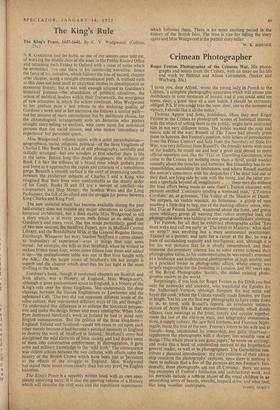Crimean Photographer
Roger Fenton, Photographer of the Crimean War. His photo- graphs and letters from the Crimea, with an essay on his life and work by Helmut and Alison Gernsheim. (Seeker and Warburg, 30s.) 'I SEND you, dear Alfred,' wrote the young lady in Punch to the Crimea, 'a complete photographic apparatus which will amuse you doubtlessly in your moments of leisure, and if you could send me home, dear, a good view of a nice battle, I should be extremely obliged. P.S. If you could take the view, dear, just in the moment of victory, I should like it all the better.' Thomas Agnew and Sons, publishers, when they sent Roger Fenton to the Crimea to photograph 'scenes of historical interest, with the object of selling them to the public,' might have instructed him in not very different terms. The public wanted the rosy and heroic side of the war; Russell of The Times had already given them its horrors. But Fenton's position, with letters of introduction from the Prince Consort and help from the Secretary of State for War, was very different from Russell's. On friendly terms with most of the leaders, he could see and hear a good deal denied to more official reporters and, like the 'TGs' or Travelling Gentlemen, who came to the Crimea for nothing more than a thrill, could wander casually about the trenches and batteries. But friendship has its re- sponsibilities, amiability its limitations, and where Russell startled the nation's conscience with his despatches ('The dead laid out as they died, are lying side by side with the living, and thelatter pre- sent a spectacle beyond all imagination . . . these men die without the least effort being made to save them'), Fenton charmed with pictures entitled Vantiniere tending a wounded man,' 'L'Entente Cordiale,' or, at grimmest, 'The Valley of the Shadow of Death.' No corpses, no visible wounds, no bitterness : a group of men teaching a little dog to beg, one of the dashing officers' wives, who, like TGs or Fenton himself, wandered about the front, and group upon whiskery group all wearing that rather crumpled look old photographs show was habitual to our great-grandfathers' clothing.
Yet Fenton, for all that he exhibited photographs called 'You must wake and call me early' or *The letter to Mamma : what shall we write?' was anything but a mere sentimental practitioner. Trained as a painter, and later for a career at the Bar, he was a man of outstanding capacity and intelligence; and, although it is for his war pictures that he is chiefly remembered, and their immense documentary interest has to some extent eclipsed their photographic value, to his contemporaries he was equally esteemed as a landscape and architectural photographer of high quality, and as a practical leader in photographic affairs, whose energy was largely responsible for the founding in London, just 101 years ago, of the Royal Photographic Society, the oldest existing photo- graphic society in the world.


































 Previous page
Previous page